Public Health: Analyzing Arabinoxylan & Resistant Starch on Gut Health
VerifiedAdded on 2023/04/25
|6
|1257
|84
Report
AI Summary
This report analyzes a research article focusing on the effects of arabinoxylan (AX) and resistant starch (RS) on intestinal microbiota and short-chain fatty acids in subjects with metabolic syndrome. The original study employed a randomized crossover design to investigate the impact of a healthy-carbohydrate diet (HCD) enriched with AX and RS, compared to a low-fiber western diet (WSD). The research assessed outcomes such as general well-being and gastrointestinal symptoms using validated questionnaires. The report reviews the study's rationale, population selection, exposure definition, outcome measurements, and statistical significance, concluding that a diet rich in RS and AX can modify the gut microbiome and improve symptoms of metabolic syndrome. The report also identifies strengths and limitations of the study, discusses implications for dietary guidelines, and proposes further research questions. Desklib offers a wealth of similar solved assignments and past papers for students.
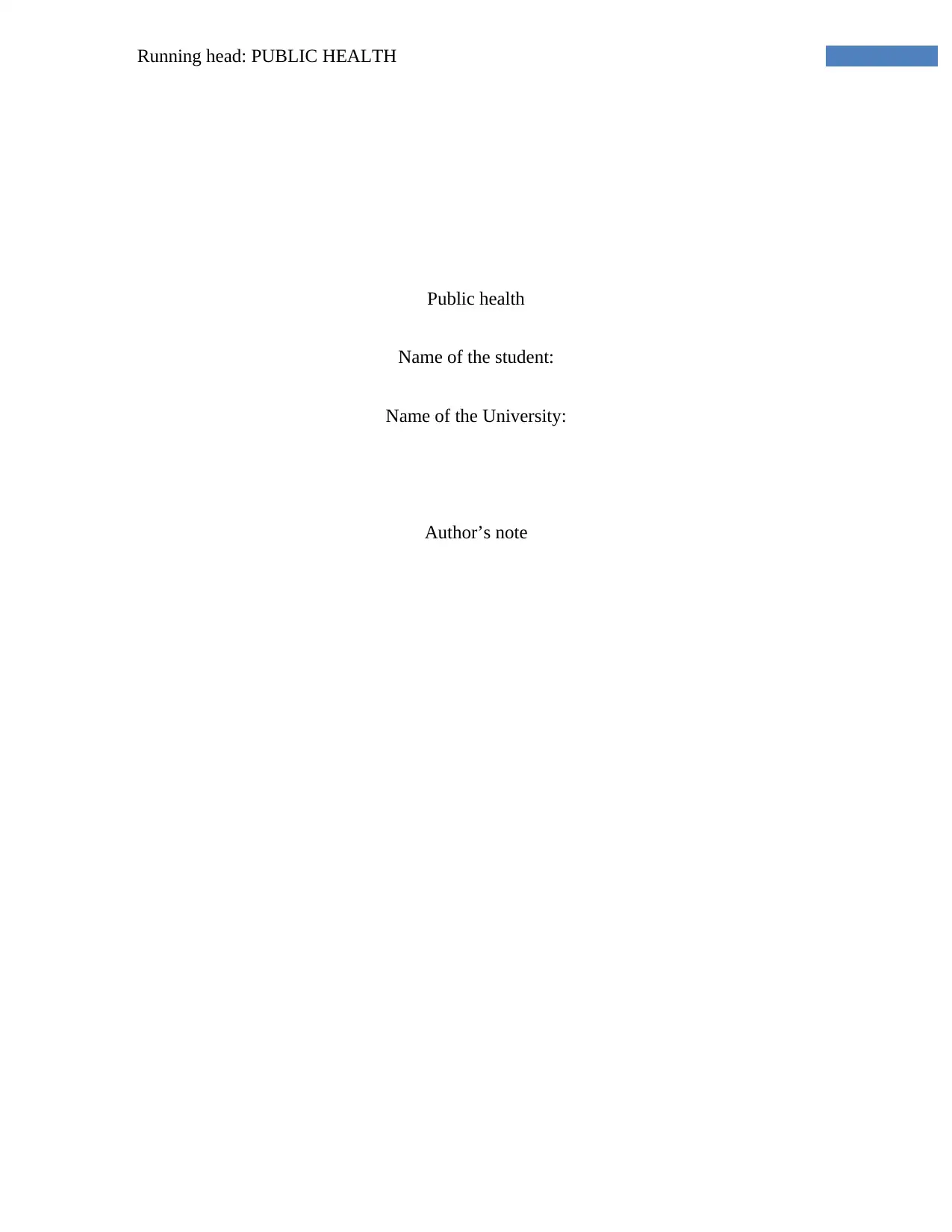
Running head: PUBLIC HEALTH
Public health
Name of the student:
Name of the University:
Author’s note
Public health
Name of the student:
Name of the University:
Author’s note
Paraphrase This Document
Need a fresh take? Get an instant paraphrase of this document with our AI Paraphraser
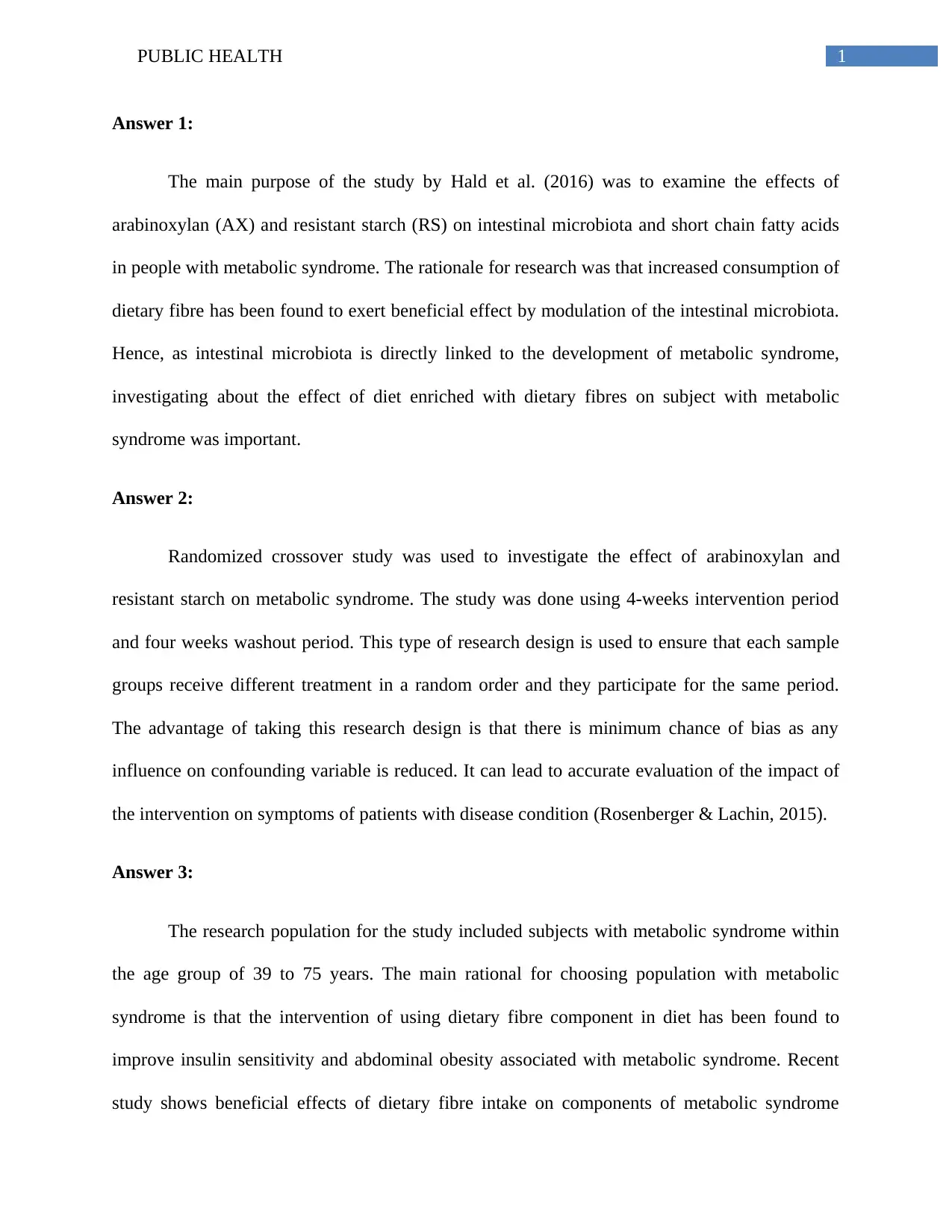
1PUBLIC HEALTH
Answer 1:
The main purpose of the study by Hald et al. (2016) was to examine the effects of
arabinoxylan (AX) and resistant starch (RS) on intestinal microbiota and short chain fatty acids
in people with metabolic syndrome. The rationale for research was that increased consumption of
dietary fibre has been found to exert beneficial effect by modulation of the intestinal microbiota.
Hence, as intestinal microbiota is directly linked to the development of metabolic syndrome,
investigating about the effect of diet enriched with dietary fibres on subject with metabolic
syndrome was important.
Answer 2:
Randomized crossover study was used to investigate the effect of arabinoxylan and
resistant starch on metabolic syndrome. The study was done using 4-weeks intervention period
and four weeks washout period. This type of research design is used to ensure that each sample
groups receive different treatment in a random order and they participate for the same period.
The advantage of taking this research design is that there is minimum chance of bias as any
influence on confounding variable is reduced. It can lead to accurate evaluation of the impact of
the intervention on symptoms of patients with disease condition (Rosenberger & Lachin, 2015).
Answer 3:
The research population for the study included subjects with metabolic syndrome within
the age group of 39 to 75 years. The main rational for choosing population with metabolic
syndrome is that the intervention of using dietary fibre component in diet has been found to
improve insulin sensitivity and abdominal obesity associated with metabolic syndrome. Recent
study shows beneficial effects of dietary fibre intake on components of metabolic syndrome
Answer 1:
The main purpose of the study by Hald et al. (2016) was to examine the effects of
arabinoxylan (AX) and resistant starch (RS) on intestinal microbiota and short chain fatty acids
in people with metabolic syndrome. The rationale for research was that increased consumption of
dietary fibre has been found to exert beneficial effect by modulation of the intestinal microbiota.
Hence, as intestinal microbiota is directly linked to the development of metabolic syndrome,
investigating about the effect of diet enriched with dietary fibres on subject with metabolic
syndrome was important.
Answer 2:
Randomized crossover study was used to investigate the effect of arabinoxylan and
resistant starch on metabolic syndrome. The study was done using 4-weeks intervention period
and four weeks washout period. This type of research design is used to ensure that each sample
groups receive different treatment in a random order and they participate for the same period.
The advantage of taking this research design is that there is minimum chance of bias as any
influence on confounding variable is reduced. It can lead to accurate evaluation of the impact of
the intervention on symptoms of patients with disease condition (Rosenberger & Lachin, 2015).
Answer 3:
The research population for the study included subjects with metabolic syndrome within
the age group of 39 to 75 years. The main rational for choosing population with metabolic
syndrome is that the intervention of using dietary fibre component in diet has been found to
improve insulin sensitivity and abdominal obesity associated with metabolic syndrome. Recent
study shows beneficial effects of dietary fibre intake on components of metabolic syndrome
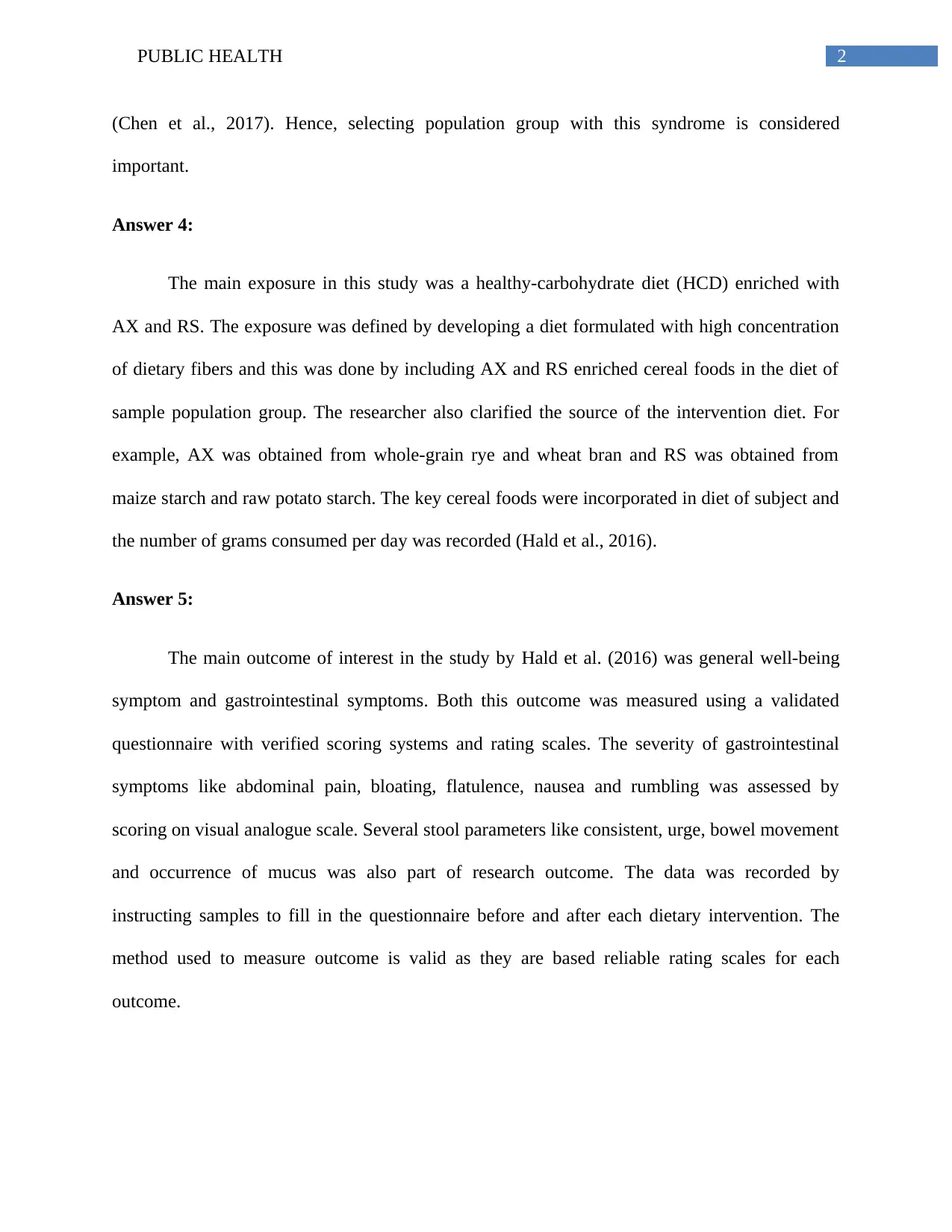
2PUBLIC HEALTH
(Chen et al., 2017). Hence, selecting population group with this syndrome is considered
important.
Answer 4:
The main exposure in this study was a healthy-carbohydrate diet (HCD) enriched with
AX and RS. The exposure was defined by developing a diet formulated with high concentration
of dietary fibers and this was done by including AX and RS enriched cereal foods in the diet of
sample population group. The researcher also clarified the source of the intervention diet. For
example, AX was obtained from whole-grain rye and wheat bran and RS was obtained from
maize starch and raw potato starch. The key cereal foods were incorporated in diet of subject and
the number of grams consumed per day was recorded (Hald et al., 2016).
Answer 5:
The main outcome of interest in the study by Hald et al. (2016) was general well-being
symptom and gastrointestinal symptoms. Both this outcome was measured using a validated
questionnaire with verified scoring systems and rating scales. The severity of gastrointestinal
symptoms like abdominal pain, bloating, flatulence, nausea and rumbling was assessed by
scoring on visual analogue scale. Several stool parameters like consistent, urge, bowel movement
and occurrence of mucus was also part of research outcome. The data was recorded by
instructing samples to fill in the questionnaire before and after each dietary intervention. The
method used to measure outcome is valid as they are based reliable rating scales for each
outcome.
(Chen et al., 2017). Hence, selecting population group with this syndrome is considered
important.
Answer 4:
The main exposure in this study was a healthy-carbohydrate diet (HCD) enriched with
AX and RS. The exposure was defined by developing a diet formulated with high concentration
of dietary fibers and this was done by including AX and RS enriched cereal foods in the diet of
sample population group. The researcher also clarified the source of the intervention diet. For
example, AX was obtained from whole-grain rye and wheat bran and RS was obtained from
maize starch and raw potato starch. The key cereal foods were incorporated in diet of subject and
the number of grams consumed per day was recorded (Hald et al., 2016).
Answer 5:
The main outcome of interest in the study by Hald et al. (2016) was general well-being
symptom and gastrointestinal symptoms. Both this outcome was measured using a validated
questionnaire with verified scoring systems and rating scales. The severity of gastrointestinal
symptoms like abdominal pain, bloating, flatulence, nausea and rumbling was assessed by
scoring on visual analogue scale. Several stool parameters like consistent, urge, bowel movement
and occurrence of mucus was also part of research outcome. The data was recorded by
instructing samples to fill in the questionnaire before and after each dietary intervention. The
method used to measure outcome is valid as they are based reliable rating scales for each
outcome.
⊘ This is a preview!⊘
Do you want full access?
Subscribe today to unlock all pages.

Trusted by 1+ million students worldwide
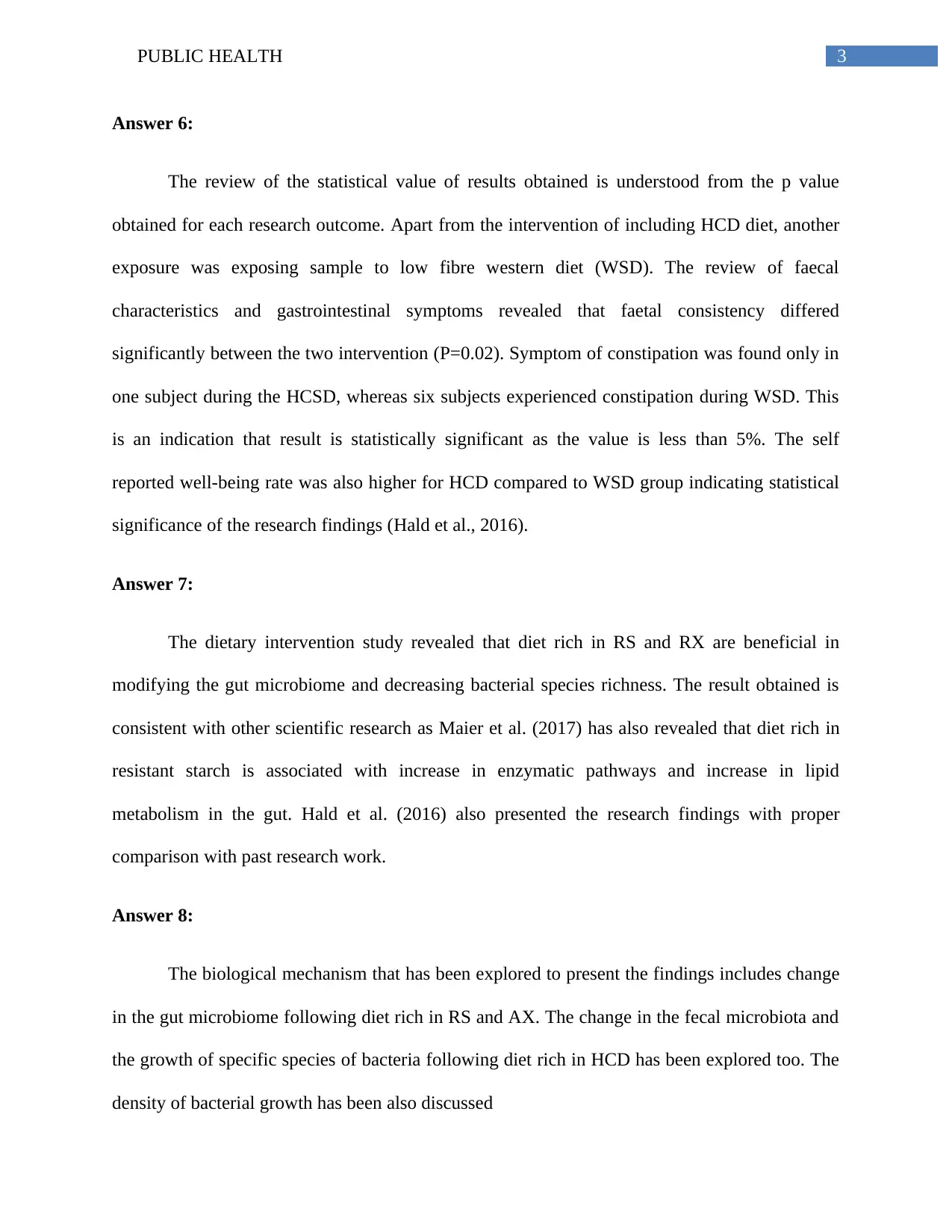
3PUBLIC HEALTH
Answer 6:
The review of the statistical value of results obtained is understood from the p value
obtained for each research outcome. Apart from the intervention of including HCD diet, another
exposure was exposing sample to low fibre western diet (WSD). The review of faecal
characteristics and gastrointestinal symptoms revealed that faetal consistency differed
significantly between the two intervention (P=0.02). Symptom of constipation was found only in
one subject during the HCSD, whereas six subjects experienced constipation during WSD. This
is an indication that result is statistically significant as the value is less than 5%. The self
reported well-being rate was also higher for HCD compared to WSD group indicating statistical
significance of the research findings (Hald et al., 2016).
Answer 7:
The dietary intervention study revealed that diet rich in RS and RX are beneficial in
modifying the gut microbiome and decreasing bacterial species richness. The result obtained is
consistent with other scientific research as Maier et al. (2017) has also revealed that diet rich in
resistant starch is associated with increase in enzymatic pathways and increase in lipid
metabolism in the gut. Hald et al. (2016) also presented the research findings with proper
comparison with past research work.
Answer 8:
The biological mechanism that has been explored to present the findings includes change
in the gut microbiome following diet rich in RS and AX. The change in the fecal microbiota and
the growth of specific species of bacteria following diet rich in HCD has been explored too. The
density of bacterial growth has been also discussed
Answer 6:
The review of the statistical value of results obtained is understood from the p value
obtained for each research outcome. Apart from the intervention of including HCD diet, another
exposure was exposing sample to low fibre western diet (WSD). The review of faecal
characteristics and gastrointestinal symptoms revealed that faetal consistency differed
significantly between the two intervention (P=0.02). Symptom of constipation was found only in
one subject during the HCSD, whereas six subjects experienced constipation during WSD. This
is an indication that result is statistically significant as the value is less than 5%. The self
reported well-being rate was also higher for HCD compared to WSD group indicating statistical
significance of the research findings (Hald et al., 2016).
Answer 7:
The dietary intervention study revealed that diet rich in RS and RX are beneficial in
modifying the gut microbiome and decreasing bacterial species richness. The result obtained is
consistent with other scientific research as Maier et al. (2017) has also revealed that diet rich in
resistant starch is associated with increase in enzymatic pathways and increase in lipid
metabolism in the gut. Hald et al. (2016) also presented the research findings with proper
comparison with past research work.
Answer 8:
The biological mechanism that has been explored to present the findings includes change
in the gut microbiome following diet rich in RS and AX. The change in the fecal microbiota and
the growth of specific species of bacteria following diet rich in HCD has been explored too. The
density of bacterial growth has been also discussed
Paraphrase This Document
Need a fresh take? Get an instant paraphrase of this document with our AI Paraphraser
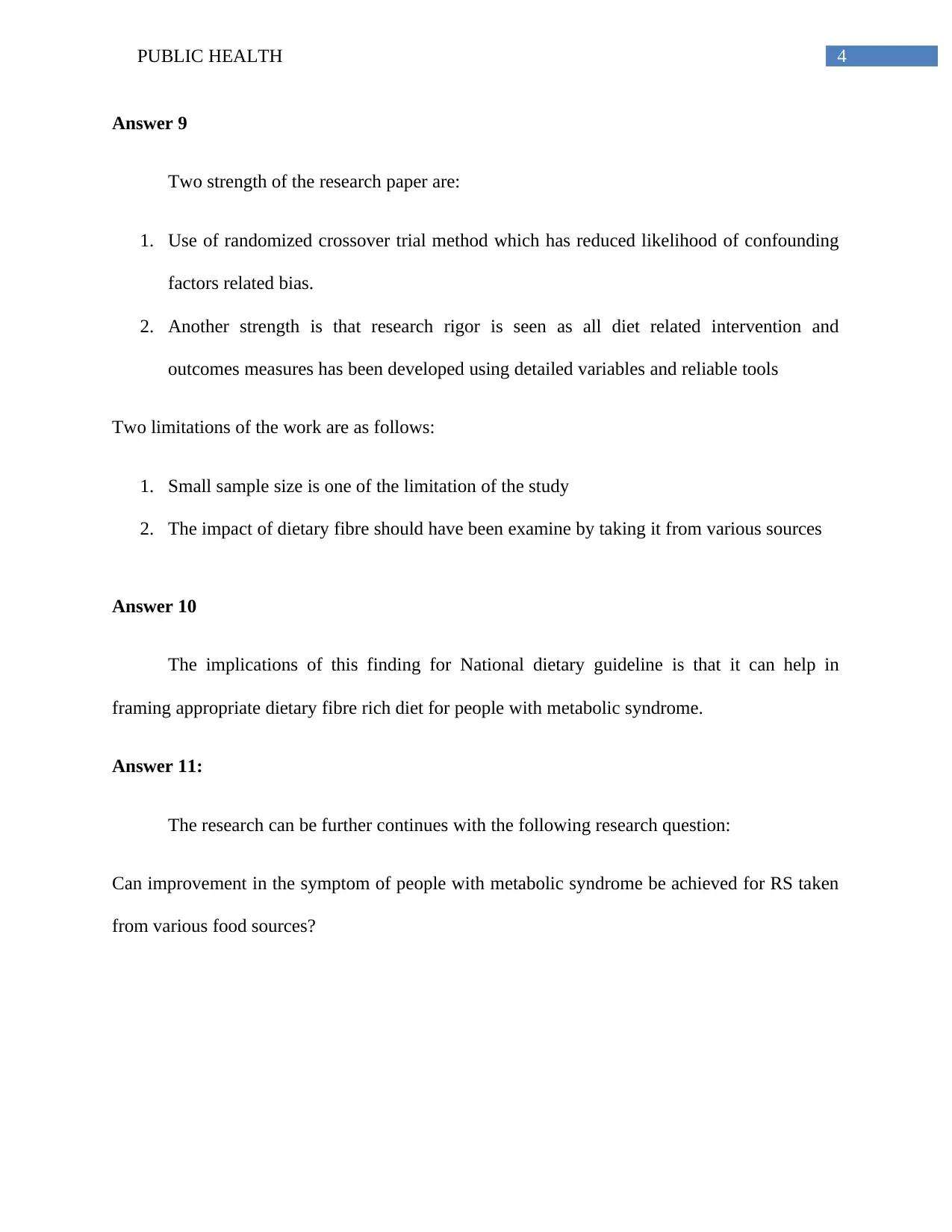
4PUBLIC HEALTH
Answer 9
Two strength of the research paper are:
1. Use of randomized crossover trial method which has reduced likelihood of confounding
factors related bias.
2. Another strength is that research rigor is seen as all diet related intervention and
outcomes measures has been developed using detailed variables and reliable tools
Two limitations of the work are as follows:
1. Small sample size is one of the limitation of the study
2. The impact of dietary fibre should have been examine by taking it from various sources
Answer 10
The implications of this finding for National dietary guideline is that it can help in
framing appropriate dietary fibre rich diet for people with metabolic syndrome.
Answer 11:
The research can be further continues with the following research question:
Can improvement in the symptom of people with metabolic syndrome be achieved for RS taken
from various food sources?
Answer 9
Two strength of the research paper are:
1. Use of randomized crossover trial method which has reduced likelihood of confounding
factors related bias.
2. Another strength is that research rigor is seen as all diet related intervention and
outcomes measures has been developed using detailed variables and reliable tools
Two limitations of the work are as follows:
1. Small sample size is one of the limitation of the study
2. The impact of dietary fibre should have been examine by taking it from various sources
Answer 10
The implications of this finding for National dietary guideline is that it can help in
framing appropriate dietary fibre rich diet for people with metabolic syndrome.
Answer 11:
The research can be further continues with the following research question:
Can improvement in the symptom of people with metabolic syndrome be achieved for RS taken
from various food sources?
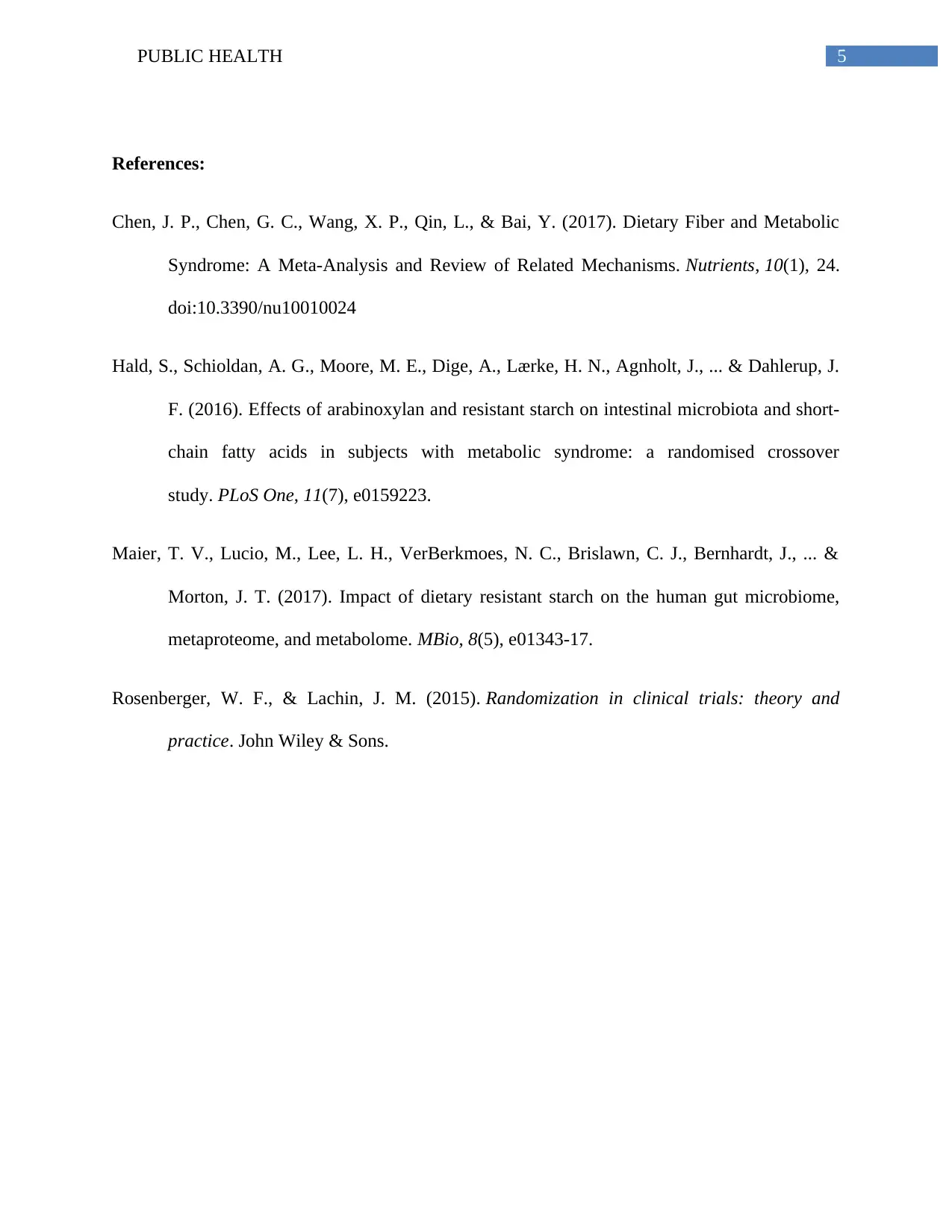
5PUBLIC HEALTH
References:
Chen, J. P., Chen, G. C., Wang, X. P., Qin, L., & Bai, Y. (2017). Dietary Fiber and Metabolic
Syndrome: A Meta-Analysis and Review of Related Mechanisms. Nutrients, 10(1), 24.
doi:10.3390/nu10010024
Hald, S., Schioldan, A. G., Moore, M. E., Dige, A., Lærke, H. N., Agnholt, J., ... & Dahlerup, J.
F. (2016). Effects of arabinoxylan and resistant starch on intestinal microbiota and short-
chain fatty acids in subjects with metabolic syndrome: a randomised crossover
study. PLoS One, 11(7), e0159223.
Maier, T. V., Lucio, M., Lee, L. H., VerBerkmoes, N. C., Brislawn, C. J., Bernhardt, J., ... &
Morton, J. T. (2017). Impact of dietary resistant starch on the human gut microbiome,
metaproteome, and metabolome. MBio, 8(5), e01343-17.
Rosenberger, W. F., & Lachin, J. M. (2015). Randomization in clinical trials: theory and
practice. John Wiley & Sons.
References:
Chen, J. P., Chen, G. C., Wang, X. P., Qin, L., & Bai, Y. (2017). Dietary Fiber and Metabolic
Syndrome: A Meta-Analysis and Review of Related Mechanisms. Nutrients, 10(1), 24.
doi:10.3390/nu10010024
Hald, S., Schioldan, A. G., Moore, M. E., Dige, A., Lærke, H. N., Agnholt, J., ... & Dahlerup, J.
F. (2016). Effects of arabinoxylan and resistant starch on intestinal microbiota and short-
chain fatty acids in subjects with metabolic syndrome: a randomised crossover
study. PLoS One, 11(7), e0159223.
Maier, T. V., Lucio, M., Lee, L. H., VerBerkmoes, N. C., Brislawn, C. J., Bernhardt, J., ... &
Morton, J. T. (2017). Impact of dietary resistant starch on the human gut microbiome,
metaproteome, and metabolome. MBio, 8(5), e01343-17.
Rosenberger, W. F., & Lachin, J. M. (2015). Randomization in clinical trials: theory and
practice. John Wiley & Sons.
⊘ This is a preview!⊘
Do you want full access?
Subscribe today to unlock all pages.

Trusted by 1+ million students worldwide
1 out of 6
Your All-in-One AI-Powered Toolkit for Academic Success.
+13062052269
info@desklib.com
Available 24*7 on WhatsApp / Email
![[object Object]](/_next/static/media/star-bottom.7253800d.svg)
Unlock your academic potential
Copyright © 2020–2025 A2Z Services. All Rights Reserved. Developed and managed by ZUCOL.